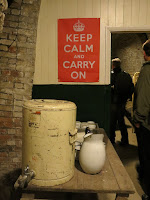 |
| Fort Amherst, Chatham |
 |
| Fort Amherst, Chatham |
It took them a long time to actually get around to it though, and it was 1755 before work started. They made use of an old chalk pit, extending out the caves to form a big network of tunnels. With their own well, cannon positions and entrances that were strategically planned to improve their defence, the tunnels gave an excellent base for the garrison to defend the dockyards.
One small artefact that I found interesting was a petard, which is a lump of cast iron with a hollow centre. The well was filled with gunpowder and hung on the gates of a fortified structure, with the opening against the gate.
When the gunpowder was lit, if done correctly, it would blast open the gate. Of course, setting these was a dangerous task, with a nasty death awaiting should the job be done wrong, or the powder blew too early. In which case you were said to be 'hoist on your own petard'.
I was a little concerned to hear about the SS Richard Montgomery, a US Liberty ship still containing around a quarter (1,400 tonnes) of its cargo of ammunition and explosives, that was wrecked in 1944. It remains there, only 1,2 miles offshore near Sheerness, in water shallow enough that you can see the top of the masts poking up, with the structure of the vessel deteriorating. If the contents were to detonate, it would cause a vast explosion, which, depending on which account you read, could blow out every window in Sheerness, or kill thousands of people.
 |
| Fort Amherst, Chatham |
One small artefact that I found interesting was a petard, which is a lump of cast iron with a hollow centre. The well was filled with gunpowder and hung on the gates of a fortified structure, with the opening against the gate.
 |
| Fort Amherst, Chatham |
 |
| Fort Amherst, Chatham |
I was a little concerned to hear about the SS Richard Montgomery, a US Liberty ship still containing around a quarter (1,400 tonnes) of its cargo of ammunition and explosives, that was wrecked in 1944. It remains there, only 1,2 miles offshore near Sheerness, in water shallow enough that you can see the top of the masts poking up, with the structure of the vessel deteriorating. If the contents were to detonate, it would cause a vast explosion, which, depending on which account you read, could blow out every window in Sheerness, or kill thousands of people.
 |
| Fort Amherst, Chatham |
 |
| Fort Amherst, Chatham |
 |
| Fort Amherst, Chatham |
 |
| Fort Amherst, Chatham |
 |
| Fort Amherst, Chatham |
 |
| Fort Amherst, Chatham |
 |
| Fort Amherst, Chatham |
 |
| Fort Amherst, Chatham |
 |
| Fort Amherst, Chatham |
No comments:
Post a Comment
We like to hear from you too, so please leave us a message here. We are also happy to answer any questions if we can help. Comments are moderated so will not appear straight away and there could be some delay in replying if we are travelling.